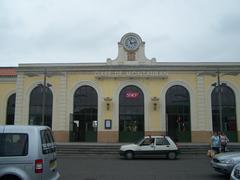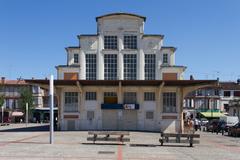Montauban Cathedral Visiting Hours, Tickets, and Historical Significance: A Comprehensive Guide
Date: 03/07/2025
Introduction
Rising gracefully in the heart of Montauban, France, Montauban Cathedral—officially Cathédrale Notre-Dame-de-l’Assomption—stands as a monument to the city’s layered history, religious heritage, and architectural ambition. Renowned for its harmonious blend of Baroque and Neoclassical styles, this cathedral not only captures the eye with its pale limestone façade but also serves as a focal point for communal, spiritual, and cultural life in Montauban. This guide delivers everything you need to know for an enriching visit, including current visiting hours, ticket information, accessibility, architectural highlights, and recommendations for nearby attractions. For the most up-to-date details, consult trusted resources such as the official Montauban tourism website, France This Way, and Trip101.
Table of Contents
- Architectural Style and Historical Context
- Exterior and Interior Features
- Artistic and Cultural Heritage
- Symbolism, Urban Setting, and Community Role
- Visiting Montauban Cathedral
- Accessibility and Practical Tips
- Nearby Attractions
- Visuals and Media Recommendations
- Frequently Asked Questions (FAQ)
- Conclusion and Travel Resources
Architectural Style and Historical Context
Montauban Cathedral is a remarkable example of the architectural evolution that bridged Baroque exuberance and Neoclassical restraint in early 18th-century France. Construction began in 1719 and concluded in 1739 under the guidance of François d’Orbay and Robert de Cotte, both prominent royal architects. Their choice of white limestone—transported from over 30 kilometers away—was a deliberate departure from Montauban’s traditional red brick, underscoring the cathedral’s role as a symbol of Catholic resurgence following a period of Protestant dominance in the region (touristplaces.guide; thegoodlifefrance.com).
The cathedral’s origins are deeply intertwined with the city’s turbulent history. The original medieval cathedral was destroyed during the Wars of Religion, and the current structure was built as a statement of Catholic and royal authority after the revocation of the Edict of Nantes in 1685 (Wikipedia; Musée Protestant).
Exterior and Interior Features
Exterior
The cathedral’s façade is an exemplary piece of French Baroque architecture, featuring three tiers with pilasters, cornices, and a triangular pediment. Corinthian columns frame the central entrance, while statues of saints and intricate reliefs—especially on the tympanum above the portal—depict scenes from the Assumption of the Virgin Mary. The two bell towers, capped by balustraded terraces, reflect a classical Italian influence and eschew the traditional soaring spires of Gothic cathedrals, lending a sense of symmetry and stability (trip101.com; France This Way).
Interior
Inside, the cathedral adopts a Latin cross layout. The vaulted nave is supported by Corinthian columns and rounded arches, while the sanctuary is elevated behind a triumphal arch. The high altar, fashioned from marble and gilded wood and flanked by sculpted angels, serves as a striking focal point. Vibrant stained-glass windows—some from the 19th century—illuminate the interior with colored light, and the dome above the crossing is adorned with delicate frescoes. Numerous chapels contain paintings, statues, and trompe-l’œil murals by local and regional artists (touristplaces.guide; MyCityQuest).
Artistic and Cultural Heritage
Beyond its architectural splendor, Montauban Cathedral houses significant works of art. Chief among these is the “Vœu de Louis XIII” by Jean-Auguste-Dominique Ingres, a renowned painter born in Montauban. The cathedral is also home to paintings by François Fayet and other artists, along with statuary and decorative murals that narrate religious and local history. These treasures solidify the cathedral’s status as a cultural repository and gallery for the city (France This Way).
The historic organ, still played during liturgical services and concerts, adds a musical dimension to the cathedral’s artistic legacy, making it a favored venue for choral performances and classical recitals (FranceRent).
Symbolism, Urban Setting, and Community Role
Montauban Cathedral is more than a religious structure; it is a symbol of resilience, reconciliation, and community identity. Its construction marked the reassertion of Catholicism in a region that had been a bastion of Protestantism, and its prominent location—overlooking the Place Nationale—anchors it in the city’s urban and social fabric (thegoodlifefrance.com; Wikipedia).
The cathedral continues to serve as a living monument, hosting not only religious ceremonies but also civic events, musical performances, and community gatherings. It plays an active role in local charity, education, and outreach programs, fostering solidarity and cultural exchange (FranceRent; Visit Places France).
Visiting Montauban Cathedral
Current Visiting Hours and Ticket Information
As of the latest updates, Montauban Cathedral is temporarily closed for structural repairs following the discovery of cracks in November 2020. Reopening dates and visiting hours are subject to change; always consult the official Montauban tourism site or local visitor centers for the most current information (Wikipedia FR).
- Standard visiting hours (when open): 9:00 AM to 6:00 PM daily, with possible variations for holidays, religious services, or events.
- Admission: Entry is typically free. Tickets may be required for special exhibitions or guided tours.
Guided Tours and Events
Guided tours, which provide in-depth historical and artistic interpretation, are available periodically—especially for groups or during special events. Booking in advance is recommended for these experiences (Visit Places France). The cathedral also hosts concerts, festivals, and liturgical celebrations throughout the year.
Accessibility and Practical Tips
- Mobility: The main entrance features steps; however, staff are generally accommodating, and interior spaces are wide and navigable. Accessibility features such as ramps and designated seating are available, and assistance can be requested.
- Facilities: Restrooms are not available within the cathedral but can be found nearby in the city center.
- Photography: Permitted without flash outside services. Please maintain a respectful atmosphere, particularly during religious ceremonies.
- Attire: Modest clothing is recommended, in line with local customs for places of worship.
- Security: As with any popular site, remain attentive to personal belongings during busy periods.
Nearby Attractions
Montauban Cathedral’s central location makes it a perfect starting point for exploring the city’s historic core. Notable nearby attractions include:
- Place Nationale: The city’s main square, surrounded by arcades and vibrant cafés.
- Musée Ingres Bourdelle: Celebrating local artists Ingres and Bourdelle.
- Jardin des Plantes: A tranquil public garden.
- Pont Vieux: The city’s iconic old bridge.
- Tarn River Promenade: Ideal for a scenic walk before or after your cathedral visit.
Visuals and Media Recommendations
For an immersive preview, explore official websites that offer high-quality images and virtual tours of the cathedral, both interior and exterior. Use alt text such as “Montauban Cathedral visiting hours” or “Montauban historical sites” to enhance accessibility and search engine optimization.
Frequently Asked Questions (FAQ)
Q: What are the Montauban Cathedral visiting hours?
A: Typically 9:00 AM to 6:00 PM, but the cathedral is currently closed for restoration. Check official sources for updates.
Q: Is there an entry fee?
A: Entry is generally free. Tickets may be required for guided tours or events.
Q: Is the cathedral accessible for visitors with disabilities?
A: Yes. While the main entrance has steps, staff can assist, and the interior is relatively accessible.
Q: Are guided tours available?
A: Guided tours are periodically offered and are best booked in advance, especially for groups.
Q: Can I take photos inside?
A: Yes, photography is allowed (without flash) and outside of services.
Q: What nearby attractions should I visit?
A: Place Nationale, Musée Ingres Bourdelle, Jardin des Plantes, Pont Vieux, and the Tarn River promenade.
Conclusion and Travel Resources
Montauban Cathedral stands as a beacon of history, faith, and artistic achievement, integrating seamlessly into the daily and cultural life of the city. Whether you are passionate about architecture, art, or history—or simply seeking a tranquil spiritual retreat—this cathedral offers an unforgettable experience.
Plan your visit:
- Consult the official Montauban tourism site for reopening notices, current visiting hours, and event calendars.
- Download the Audiala app for curated audio guides and the latest updates on Montauban Cathedral and other regional sites.
- Follow local tourism channels and check for guided tours and special events to enrich your exploration of Montauban’s heritage.
References
- touristplaces.guide
- Trip101
- The Good Life France
- France This Way
- Musée Protestant
- FranceRent
- Wikipedia
- Wikipedia FR
- MyCityQuest
- Over Your Place
- Visit Places France
- The Crazy Tourist


